Eva Díaz
Cinerama and Sublimity
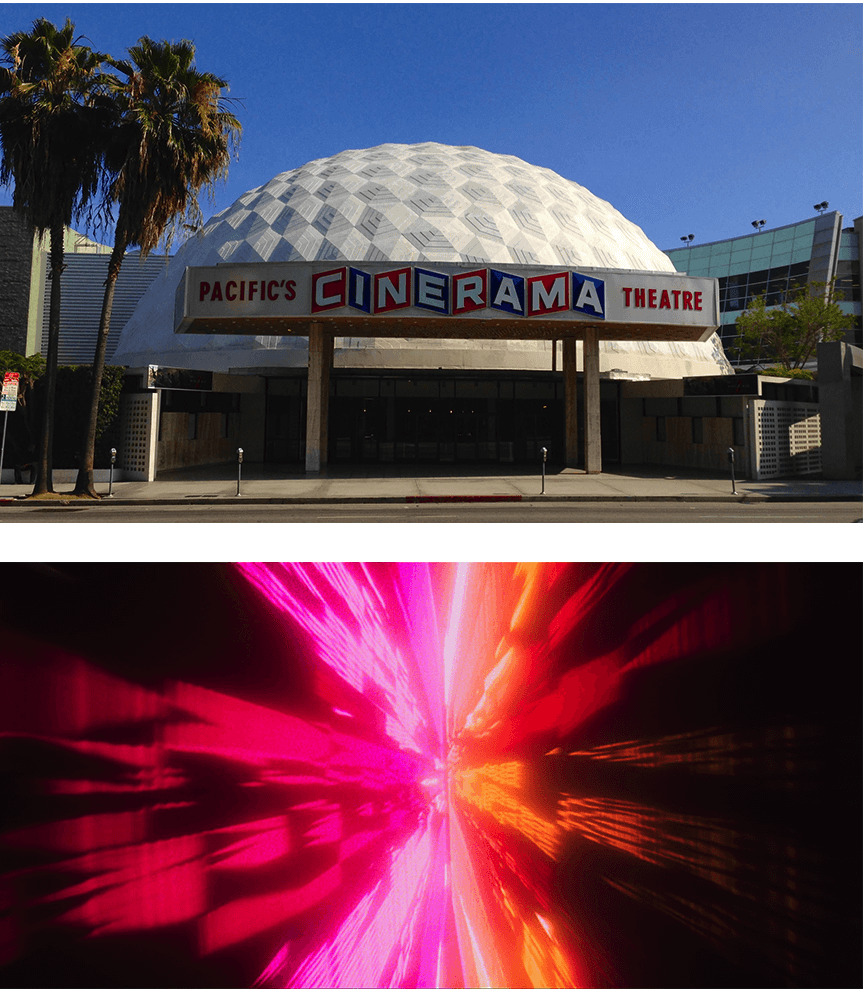
While a DIY-aesthetic often characterizes amateur builders’ and visual artists’ uses of geodesic domes, beginning in the early 1950s R. Buckminster Fuller, a great advocate of such structures, was fulfilling commissions to produce large-scale domes for various patrons. Of these, many were used as exhibition halls and national pavilions, and to this day they are the most enduring public examples of his work.1 The most memorable of Fuller’s exposition domes—the 1959 American National Exhibition in Moscow, the 1967 Montreal Expo dome (more notorious than fêted—it caught fire in 1977), and Disney World’s “Spaceship Earth” dome at Epcot Center in Florida, completed in 1982—were and continue to be popular.2


Domes as exhibition architecture were associated early on with immersive cinematic experience.3 Not only do geodesic planetarium-style pavilions feature larger internal surface and display areas than traditional post and lintel architecture, the inner shell of a dome can act as a screen for multi-sensory film and media experiences programmed as part of an overall exhibition strategy or narrative. Understanding the interior of the dome as a sensorially-complex evocation of a network can help explain why the dome acquired its inimitable role in post-war public entertainment and exhibition culture, and why domes remain common sites of film display today. The geodesic dome is an apt visual metaphor for an information network, as the strength of its interconnected lattice is derived from a nonhierarchical distribution of force. Moreover, Fuller himself promoted the idea of domes as literally networked by statistics and media.4
Thus, the dome was positioned as an important site, as Patrick Jagoda has written, for “aesthetic and affective encounters with network form” where an emerging information culture could be made sensible.5 From World’s Fairs to today’s high fashion parties, immersive dome experiences portray networks and construct subjects in competing ways. Engrossing, cinematic experiences developed for domes from the 1960s to the present day may bombard and overwhelm a largely passive subject with information, or they may train audiences in constructing their own kinds of meaning within a data flow. Domes create architectures in which viewers are expected to utilize and further develop skills about modern mediatic culture; they act as a vehicle for collective participation in learning about technological networks.
The trajectory coming out of the pavilion domes of Moscow, Montreal, and others not directly supervised by Fuller accentuates how the narrative content of film could attune viewers’ senses to the intense pressures and stimulations of new technologies using the unique spatial surrounding of a geodesic structure. A signature instance of this is Douglas Trumbull’s work, initially in his film for the so-called “Moon Dome” at the 1964 New York World’s Fair, and then in his creation of special effects for the 1968 Stanley Kubrick-directed movie 2001: A Space Odyssey, a film intended to be screened in multi-projector halls such as the concrete Cinerama Dome in Hollywood, designed in 1963 by Fuller’s student Pierre Cabrol.6
Thus, the dome was positioned as an important site, as Patrick Jagoda has written, for “aesthetic and affective encounters with network form” where an emerging information culture could be made sensible.5 From World’s Fairs to today’s high fashion parties, immersive dome experiences portray networks and construct subjects in competing ways. Engrossing, cinematic experiences developed for domes from the 1960s to the present day may bombard and overwhelm a largely passive subject with information, or they may train audiences in constructing their own kinds of meaning within a data flow. Domes create architectures in which viewers are expected to utilize and further develop skills about modern mediatic culture; they act as a vehicle for collective participation in learning about technological networks.
The trajectory coming out of the pavilion domes of Moscow, Montreal, and others not directly supervised by Fuller accentuates how the narrative content of film could attune viewers’ senses to the intense pressures and stimulations of new technologies using the unique spatial surrounding of a geodesic structure. A signature instance of this is Douglas Trumbull’s work, initially in his film for the so-called “Moon Dome” at the 1964 New York World’s Fair, and then in his creation of special effects for the 1968 Stanley Kubrick-directed movie 2001: A Space Odyssey, a film intended to be screened in multi-projector halls such as the concrete Cinerama Dome in Hollywood, designed in 1963 by Fuller’s student Pierre Cabrol.6

In 1964 the young Trumbull was hired to work on the short film To the Moon and Beyond for the 1964 World’s Fair in Corona Park, Queens. The completed film featured Trumbull’s illustrations animating a voyage through outer space. To make the images, Trumbull painted detailed circular format renderings of planets, galaxies, and astronomical phenomenon, which were then photographed with specially-designed anamorphic and fish-eye lenses.
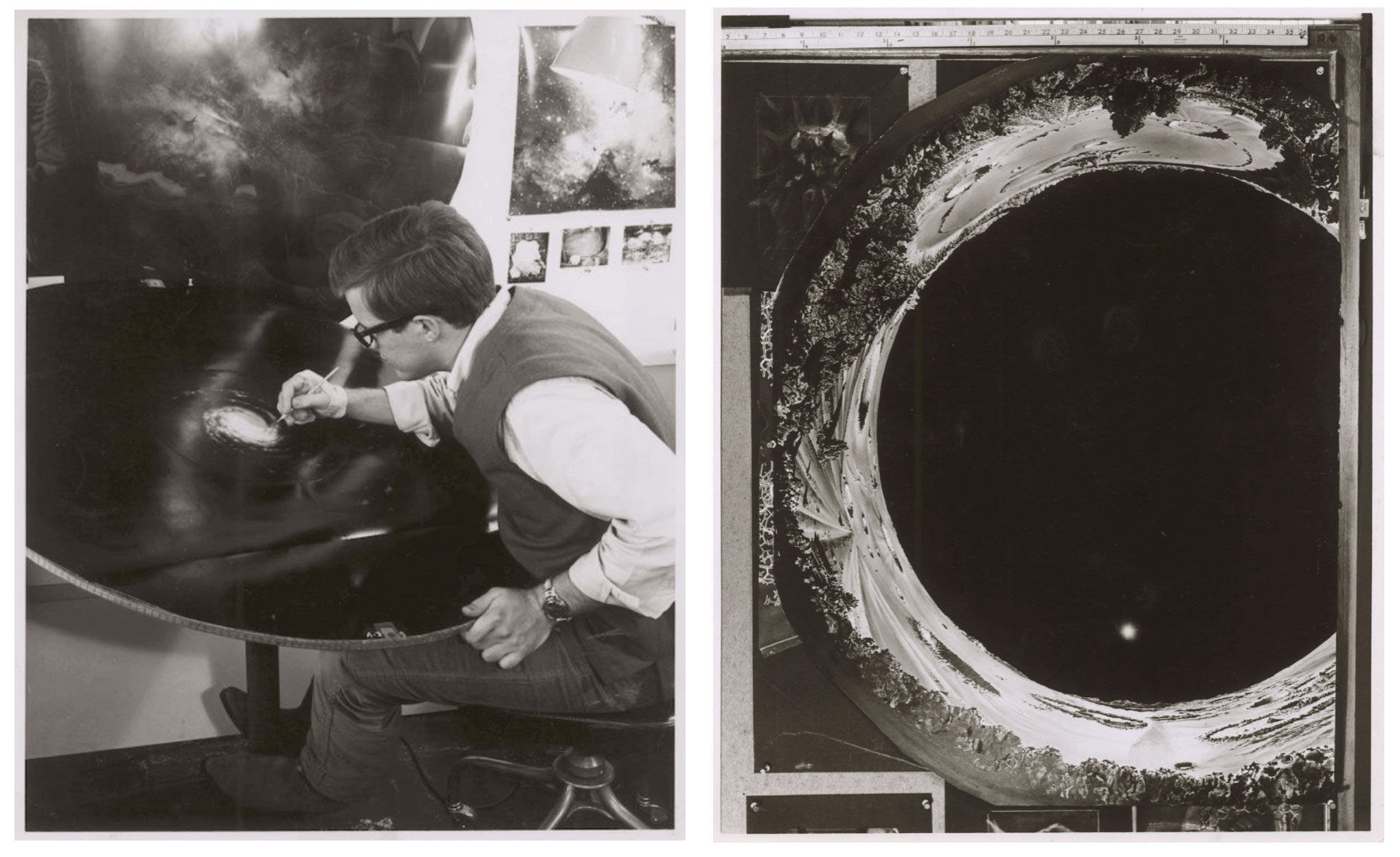
According to Graphic Films in Los Angeles, Trumbull’s employer at the time and the producer of the project, the film no longer exists: “The negative has all but turned to vinegar.”7 But as Trumbull described it, the film “was all looking up; looking at the sky, looking at the trees, looking at the microcosm, looking at the Big Bang.”8 He continued:
Director Stanley Kubrick saw To the Moon and Beyond in 1964, where it was shown in the specially constructed 96-foot high “Moon Dome” of the U.S. Transportation and Travel pavilion.10
![“Moon Dome,” World’s Fair, Queens, NY, 1964]()
Kubrick immediately hired Trumbull as an animator for an upcoming film “Journey Beyond the Stars,” an adaptation of Arthur C. Clark’s 1948 story “The Sentinel.” Re-titled again, it would be released to global acclaim in 1968 as 2001: A Space Odyssey.11 In particular, Kubrick wanted Trumbull to flesh out the “fantastic voyage” scene in which astronaut David Bowman flees the main ship in an escape pod, indicated in the script by a single sentence: “Sees astronomical wonders; the birth of galaxies; giant red stars; fiery nebulae, etc.”
![2001: A Space Odyssey script]()
From this brief, Trumbull produced ten of the most indelible minutes in film history: 2001’s famous Stargate sequence.12 As Trumbull later reflected: “In 2001 there were some intractable problems that had never been addressed in feature films, such as the Stargate space and time travel sequence. How do you transit thorough space and time visually?” He continued, “I created what I called the slit cam machine… which created patterns that didn't exist in the real world.”13
In the Stargate scene Bowman travels through space as well as time—the viewer realizes this as the character is shown aging at the film’s conclusion. The final section of the film used the adapted slit scan technique Trumbull described, which he perfected after Whitney’s use of it in To the Moon and Beyond—slit scan is a time-consuming animation method in which a camera moves towards an image obscured but for a narrow vertical slit, and progressive frames are stitched together as the camera slowly approaches the image. The source image, generally a slide illuminated from behind, may be moved horizontally left to right as the camera moves towards it.
![Slit Scan technology]()
In the sequence Bowman is shown careening through space. The viewer then sees a vortex of images that appear to propel Bowman towards an approaching horizon line, which is bifurcated, sometimes vertically, sometimes laterally. The throbbing light of the animation produces the physiological effect of rapid movement. Several reaction stills of Bowman’s pained face, seeming immobilized by the speed and intensity of the voyage, are intercut with shots of oceanic turbulence filtered in bright colors and often shown as negatives. The soundtrack features Gyorgy Ligeti’s eerie pulsing polyrythmic composition “Adventures.”
[It] was similar in some ways to what many people know as Powers of Ten, the film Charles and Ray Eames made [later], because it was the universe from the Big Bang to the microcosm in 15 minutes. It started out with a huge explosion, it was projected on to a hemispherical planetarium screen… so it was a circular image on 70mm film projected into a dome with fish eye lenses. It involved a lot of special photography of artwork, including multi-plane photography and multi-layer exposure photography in which each layer of film might consist of 50 different exposures of objects. I painted all the artwork for this movie, which was all the stars, all the planets, all the spacecraft and then down into the microcosm of cellular life and things like that. Then it culminated in a pre-slit-scan dome sequence that was made by John Whitney.9
Director Stanley Kubrick saw To the Moon and Beyond in 1964, where it was shown in the specially constructed 96-foot high “Moon Dome” of the U.S. Transportation and Travel pavilion.10
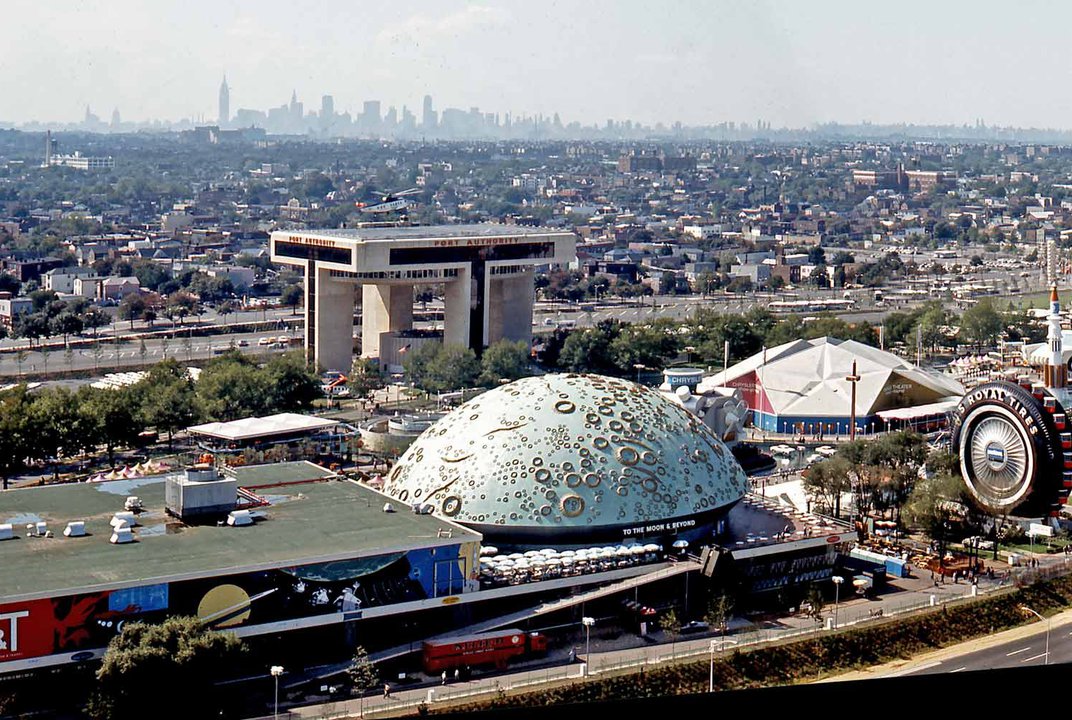
Kubrick immediately hired Trumbull as an animator for an upcoming film “Journey Beyond the Stars,” an adaptation of Arthur C. Clark’s 1948 story “The Sentinel.” Re-titled again, it would be released to global acclaim in 1968 as 2001: A Space Odyssey.11 In particular, Kubrick wanted Trumbull to flesh out the “fantastic voyage” scene in which astronaut David Bowman flees the main ship in an escape pod, indicated in the script by a single sentence: “Sees astronomical wonders; the birth of galaxies; giant red stars; fiery nebulae, etc.”
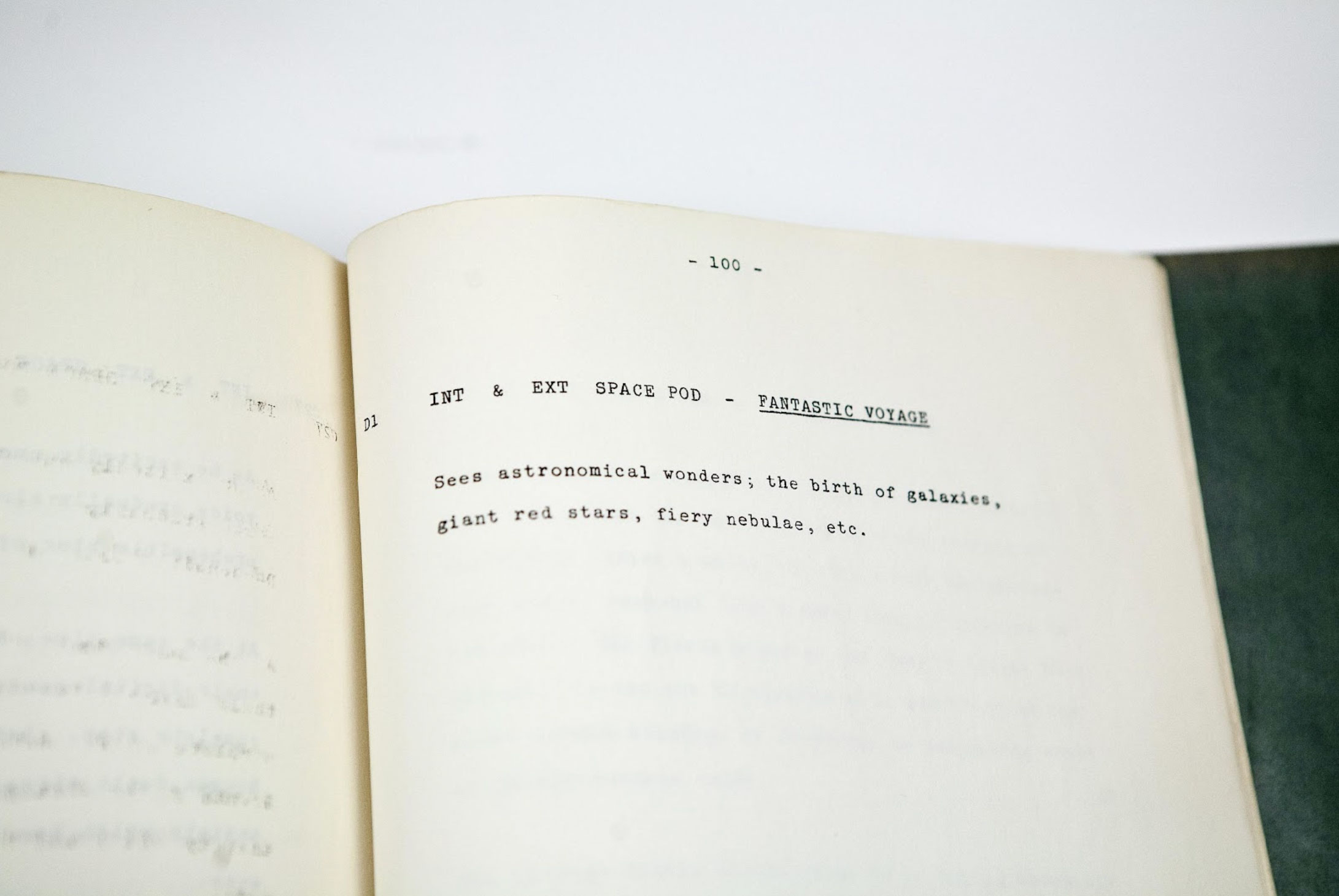
From this brief, Trumbull produced ten of the most indelible minutes in film history: 2001’s famous Stargate sequence.12 As Trumbull later reflected: “In 2001 there were some intractable problems that had never been addressed in feature films, such as the Stargate space and time travel sequence. How do you transit thorough space and time visually?” He continued, “I created what I called the slit cam machine… which created patterns that didn't exist in the real world.”13
In the Stargate scene Bowman travels through space as well as time—the viewer realizes this as the character is shown aging at the film’s conclusion. The final section of the film used the adapted slit scan technique Trumbull described, which he perfected after Whitney’s use of it in To the Moon and Beyond—slit scan is a time-consuming animation method in which a camera moves towards an image obscured but for a narrow vertical slit, and progressive frames are stitched together as the camera slowly approaches the image. The source image, generally a slide illuminated from behind, may be moved horizontally left to right as the camera moves towards it.

In the sequence Bowman is shown careening through space. The viewer then sees a vortex of images that appear to propel Bowman towards an approaching horizon line, which is bifurcated, sometimes vertically, sometimes laterally. The throbbing light of the animation produces the physiological effect of rapid movement. Several reaction stills of Bowman’s pained face, seeming immobilized by the speed and intensity of the voyage, are intercut with shots of oceanic turbulence filtered in bright colors and often shown as negatives. The soundtrack features Gyorgy Ligeti’s eerie pulsing polyrythmic composition “Adventures.”
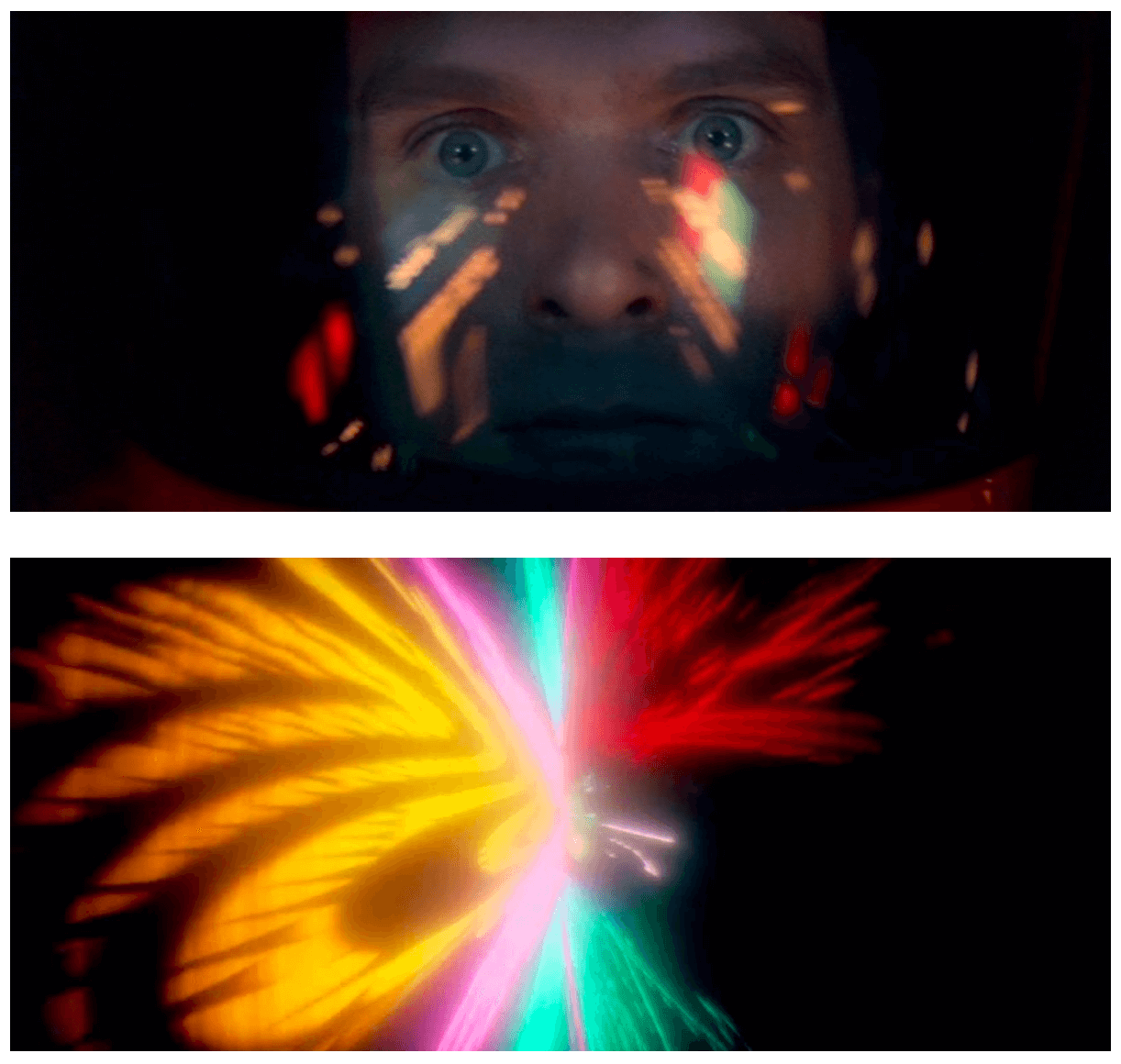
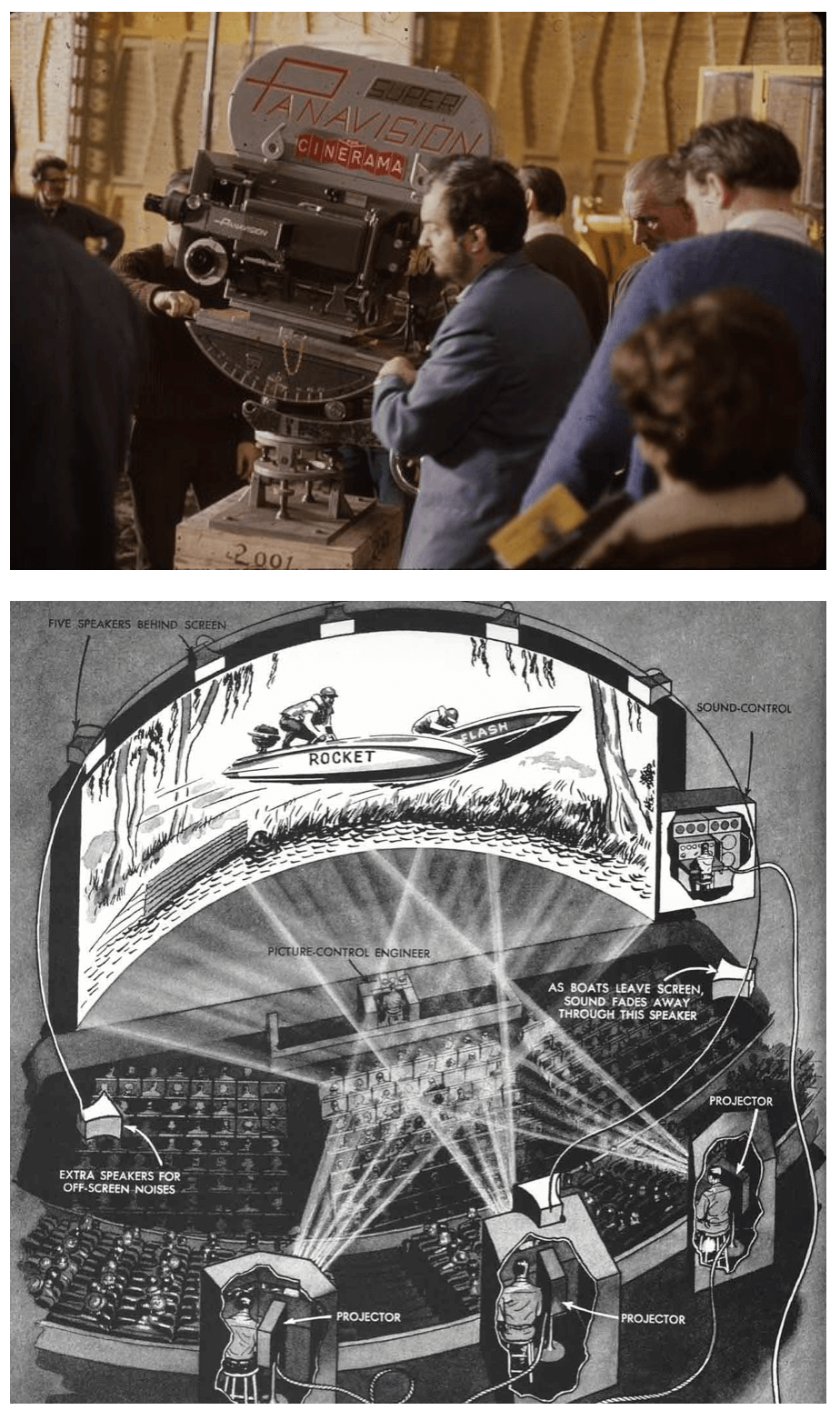
2001 was photographed in Super Panavision 70, a 70mm film intended to be shown in three-strip Cinerama, which uses three devices to create a near 150-degree projection on a deeply curved, 90-foot wide circular screen (though a lower distortion single strip system was recommended by Trumbull for smaller screens). To the Moon and Beyond had been created for Cinerama 360 projection, filling the entire upper hemisphere of the Moon Dome structure. The Moon Dome had been devised as a “ride,” an immersive first-person experience of travel through the heavens projected within the structure, though spectators were actually seated in fixed chairs.
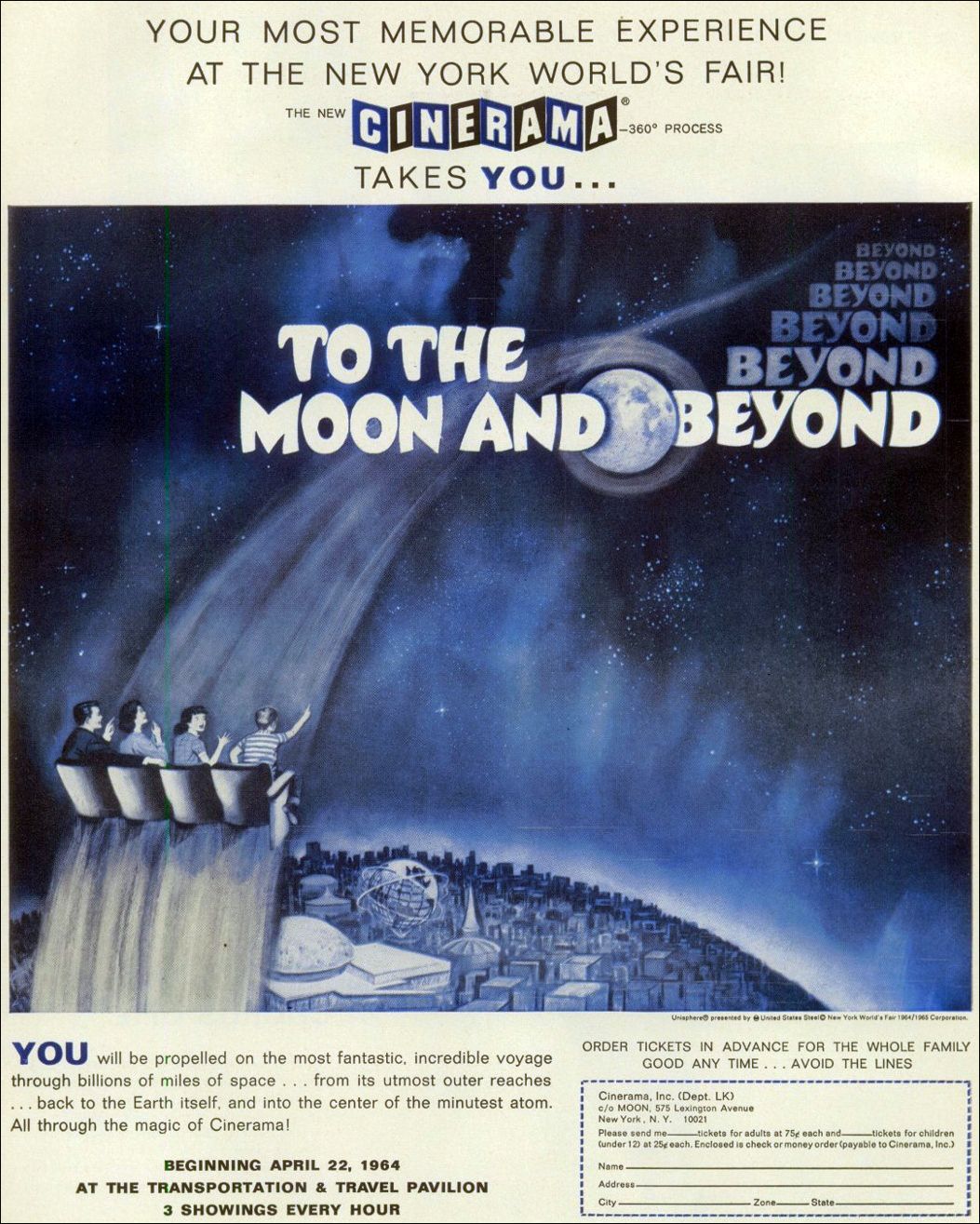
Trumbull’s technological virtuosity produced paradoxical results—he created a “realism” of the unseen, while Kubrick’s reactions shots suture the spectator into identifying with Bowman’s enervation and the strain of the journey.15 Yet the visual patterns and the hypnotic music stages velocity as a sublime threshold between consciousness and the vastness of space, which Trumbull’s special effects conjure as the distorting effects of technologically-induced speed. What Kubrick called the “epic spectacle” of the voyage, which would literally engulf viewers when shown in a three-projector theater, represents the loneliest trip ever imagined: a one-way solo-voyage through time to one’s death.16
The encompassing Cinerama projection further underscored the claustrophobic aspects of the pod as it moves through the dense imagery of the slit-scan created space horizon. As Annette Michelson wrote of 2001, the film “converts the theatre into a vessel and its viewers into passengers, it impels us… to rediscover the space and dimensions of the body as a theatre of consciousness.”17 The “consciousness” of this body is understood to participate in a collective project of re-examining relationships between technology, society, and modernity. In the Cinerama setting, the viewing subject was propelled by the ur-machine of the 1960s, the spaceship, testing viewers’ competencies in aeronautical travel, skills as crucial to master in the dawning new space age as familiarity with networks of automotive infrastructure had been in the first half of the 20th century.
End Notes
1. Among his industry commissions, the Union Tank Car Dome north of Baton Rouge, Louisiana was perhaps the most famous. Completed in 1958, it was the largest clear-span structure of its time—384 feet in diameter and 120 feet tall. It was demolished in 2007. For more on Fuller’s commissions, see Chapter 4 of After Spaceship Earth [forthcoming] for a discussion of radomes: geodesic domes commissioned by the U.S. military, which though publicly funded are most often not publicly accessible. Of course DIY dome housing has fans to this day, but most are privately-funded domestic architectures.
2. Epcot Center was designed by Wallace Floyd Design Group based on the Expo 67 dome, though the Florida dome is a complete sphere supported by three legs. The structural designs of both Expo 67 and “Spaceship Earth” were completed by Simpson Gumpertz & Heger Inc. Fuller was consulted beginning in 1972 about the design of the Epcot Center project.
3. See David McConville’s essay “Cosmological Cinema: Pedagogy, Propaganda, and Perturbation in Early Dome Theaters” for an engaging analysis of the quasi-religious nature of uniting technologies of projection, light, and spherical architectures, in Technoetic Arts: A Journal of Speculative Research 5(2): 69-85, April 2007.
4. This essay emerges from my forthcoming book After Spaceship Earth. Subsequent chapters of this book takes up Fuller’s Geoscope project and his World Game Institute, both of which emphasized the visualization of information networks as a central preoccupation towards equitable resource allocation.
5. Patrick Jagoda, Network Aesthetics (Chicago: University of Chicago Press, 2016), 3.
6. Inventor Fred Waller’s Cinerama premiered in 1952 as a three-film process shown on curved screens. Only three Cinerama halls remain in operation today. Later film projects such as 2001 were filmed using a single, 70mm film which “was projected on a deeply curved ‘louvered’ screen which wrapped the image around the audience, sweeping them into the image,” according to Thomas E. Brown in “2001's Original Projection Format,” accessed Aug. 10, 2018. This dome is set to reopen as “Cinerama Hollywood” in the coming months.
7. Correspondence with Graphic Films provided to me by Michael Connor.
8. Douglas Trumbull interviewed by Wolfram Hennemann, recorded May 10, 2012, Haus der Wirtschaft, Stuttgart, Germany and prepared by Brian Guckian for in 70mm.com, accessed on February 18, 2014.
9. Trumbull interviewed by Nathan Francis, Little White Lies, Sept. 14, 2011 http://www.littlewhitelies.co.uk/features/articles/douglas-trumbull-15324, accessed March 6, 2013.
10. The 1964 World’s Fair also included an ovoid IBM pavilion designed by the Saarinen office which included a fourteen-screen film commissioned from the Eames called Think.
11. According to Trumbull, Kubrick and Clarke referred to the project as “How the Solar System Was Won,” a reference to MGM's 1962 Cinerama epic How the West Was Won. Trumbull, “Master Class,” TIFF Learning, December 2012, accessed August 8, 2018. Trumbull would eventually be credited as Special Photographic Effects Supervisor and was also head of the film’s animation department.
12. Trumbull later went on to do special effects for the period sci-fi classics such as The Andromeda Strain (1971), Close Encounters of the Third Kind (1977), the first Star Trek film (1979), and Blade Runner (1982), though he turned down doing visual effects for Star Wars. He also directed two sci-fi films: Silent Running (1972), which features geodesic domes prominently in its plot, as well as Brainstorm (1983).
13. Trumbull, CreativeCOW.net, 2012.
14. Trumbull, “Master Class,” TIFF Learning, December 2012.
15. Annette Michelson writes of the “complex intensity of physical response,” provoked by the film in “Bodies in Space: Film as Carnal Knowledge,” Artforum, Vol. VII, no. 6, 1969, 54-63, quote on 56.
16. Trumbull, “Master Class.”
17. Michelson, “Bodies in Space,” 63.
1. Among his industry commissions, the Union Tank Car Dome north of Baton Rouge, Louisiana was perhaps the most famous. Completed in 1958, it was the largest clear-span structure of its time—384 feet in diameter and 120 feet tall. It was demolished in 2007. For more on Fuller’s commissions, see Chapter 4 of After Spaceship Earth [forthcoming] for a discussion of radomes: geodesic domes commissioned by the U.S. military, which though publicly funded are most often not publicly accessible. Of course DIY dome housing has fans to this day, but most are privately-funded domestic architectures.
2. Epcot Center was designed by Wallace Floyd Design Group based on the Expo 67 dome, though the Florida dome is a complete sphere supported by three legs. The structural designs of both Expo 67 and “Spaceship Earth” were completed by Simpson Gumpertz & Heger Inc. Fuller was consulted beginning in 1972 about the design of the Epcot Center project.
3. See David McConville’s essay “Cosmological Cinema: Pedagogy, Propaganda, and Perturbation in Early Dome Theaters” for an engaging analysis of the quasi-religious nature of uniting technologies of projection, light, and spherical architectures, in Technoetic Arts: A Journal of Speculative Research 5(2): 69-85, April 2007.
4. This essay emerges from my forthcoming book After Spaceship Earth. Subsequent chapters of this book takes up Fuller’s Geoscope project and his World Game Institute, both of which emphasized the visualization of information networks as a central preoccupation towards equitable resource allocation.
5. Patrick Jagoda, Network Aesthetics (Chicago: University of Chicago Press, 2016), 3.
6. Inventor Fred Waller’s Cinerama premiered in 1952 as a three-film process shown on curved screens. Only three Cinerama halls remain in operation today. Later film projects such as 2001 were filmed using a single, 70mm film which “was projected on a deeply curved ‘louvered’ screen which wrapped the image around the audience, sweeping them into the image,” according to Thomas E. Brown in “2001's Original Projection Format,” accessed Aug. 10, 2018. This dome is set to reopen as “Cinerama Hollywood” in the coming months.
7. Correspondence with Graphic Films provided to me by Michael Connor.
8. Douglas Trumbull interviewed by Wolfram Hennemann, recorded May 10, 2012, Haus der Wirtschaft, Stuttgart, Germany and prepared by Brian Guckian for in 70mm.com, accessed on February 18, 2014.
9. Trumbull interviewed by Nathan Francis, Little White Lies, Sept. 14, 2011 http://www.littlewhitelies.co.uk/features/articles/douglas-trumbull-15324, accessed March 6, 2013.
10. The 1964 World’s Fair also included an ovoid IBM pavilion designed by the Saarinen office which included a fourteen-screen film commissioned from the Eames called Think.
11. According to Trumbull, Kubrick and Clarke referred to the project as “How the Solar System Was Won,” a reference to MGM's 1962 Cinerama epic How the West Was Won. Trumbull, “Master Class,” TIFF Learning, December 2012, accessed August 8, 2018. Trumbull would eventually be credited as Special Photographic Effects Supervisor and was also head of the film’s animation department.
12. Trumbull later went on to do special effects for the period sci-fi classics such as The Andromeda Strain (1971), Close Encounters of the Third Kind (1977), the first Star Trek film (1979), and Blade Runner (1982), though he turned down doing visual effects for Star Wars. He also directed two sci-fi films: Silent Running (1972), which features geodesic domes prominently in its plot, as well as Brainstorm (1983).
13. Trumbull, CreativeCOW.net, 2012.
14. Trumbull, “Master Class,” TIFF Learning, December 2012.
15. Annette Michelson writes of the “complex intensity of physical response,” provoked by the film in “Bodies in Space: Film as Carnal Knowledge,” Artforum, Vol. VII, no. 6, 1969, 54-63, quote on 56.
16. Trumbull, “Master Class.”
17. Michelson, “Bodies in Space,” 63.
Eva Díaz is an art historian and critic living in Rockaway Beach, New York. She is Associate Professor of Contemporary Art in the History of Art and Design Department at Pratt Institute in Brooklyn. She received her B.A. from the University of California, Berkeley and her Ph.D. from Princeton University, and was on the faculty of the Whitney Independent Study Program for a decade after attending the program. Her book The Experimenters: Chance and Design at Black Mountain College was released by the University of Chicago Press in 2015. She writes for magazines and journals such as Aperture, The Art Bulletin, Artforum, Art Journal, Art in America, Cabinet, Frieze, Grey Room, Texte zur Kunst, Harvard Design Magazine, and October. She has recently completed the manuscript to her new book After Spaceship Earth, analyzing the influence of R. Buckminster Fuller in contemporary art, a project supported by the Graham Foundation and a Warhol Foundation / Creative Capital Art Writers Grant. Recent sections, published in New Left Review, Aperture, e-flux journal, and Texte zur Kunst, take up artists’ challenges to a privatized and highly-surveilled future in outer space, and how the space “race” and colonization can be reformulated as powerful means to readdress economic, gender, and racial inequality, as well as ecological injustices.
